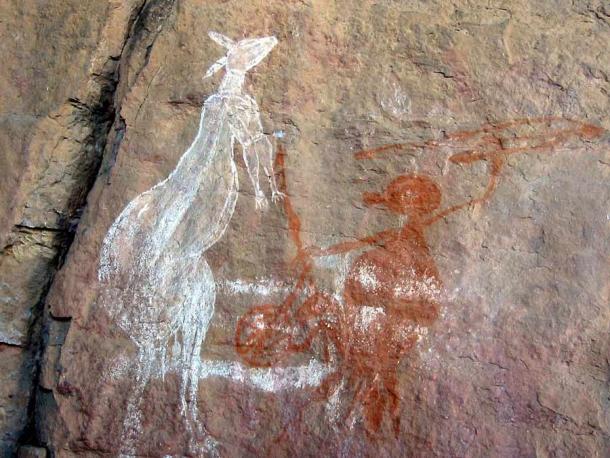Archaeologists in the Wilton River area of Australia have used computer software to read and understand Australian rock art from over a thousand years ago. The software was trained to spot different rock art styles, which were broadly labeled “Northern Running figures,” “Dynamic Figures,” “Post Dynamic figures” and “Simple figures with Boomerangs.” The Australian rock art researchers did this to see how the styles related to one another without the presence of human bias.
Dr. Ian Moffat, an archaeologist at Flinders University, explained the significance of the research on ZDNET: “This approach allows an unbiased classification of style.”
The new technology allows researchers to learn about the similarities between Australian rock art without human bias and that’s not all!

Two Mimal community members photographing Australian rock art in the Flinders River area of Australia. (Mimal Land Management Aboriginal Corporation (MLMAC) / Flinders University )
How Computers Learned To “Understand” Australian Rock Art
The researchers took more than 14 million different photos of animals, insects, and household objects to gain a wide range of data for the software to be trained on. Researchers did this to teach the computer the differences between these various objects so that it could spots specific differences by looking at a photo.
The newly created computer program allowed archaeologists to “see” comparative differences in the rock art of the Wilton River region. The machine learning program analyzed rock art images taken by archaeologists from 2018 and 2019 in Marrku County.
Dr. Wesley of the Flinders University team explained, “In total, the computer saw more than 1000 different types of objects and learned to tell the difference between them just by looking at photos of them.”
One of the study’s main purposes was to analyze the evolution and chronology of known and newly discovered Australian rock art . The results were astonishing: the computer learned to process information that would have taken humans years to look through.
What the Australian Rock Art Program Found
Through the computer program, the archaeology team discovered that some of the artwork was not quite as old as previously believed. Some of the findings revealed that human figure drawings from a single period looked more similar when compared with figures from a different period, something human researchers had not noticed. But the software did!
Jarrad Kowlessar, archaeology PhD candidate at Flinders University commented: “This shows that similarity and time are closely linked in the Arnhem Land rock art.”
The report published in Australian Archaeology explained that this was the first time a machine was used to study and analyze Australian rock art. The researchers noted their excitement of this new technology and the possibilities of further analysis on other rock art in Australia and elsewhere.
Archaeologist Dr. Ian Moffat explained the potential with the new technology to ZDNET: “This demonstrates that our approach is working and suggests it has exciting potential to contribute to rock art studies elsewhere.”

A stunning example of aboriginal rock art from the Anbangbang Rock Shelter, Kakadu National Park, Australia. (Thomas Schoch / CC BY-SA 2.5 )
A New Technology For Rock Art Researchers
This research has also created a new way of approaching machine learning called “transfer learning,” which can largely remove human interpretation errors and bias. This can help archaeologists study and research new findings without unconsciously including human biases.
A computer can “understand” the rock art and make amazing connections to other examples of this ancient painting style. For example, connections to a similar style or time period.
Researchers can now run a photo from the Wilton River region and the Arnhem region and compare the rock art from two geographically separate locations. This offers new insights into how the people lived and viewed art during these periods in different places across ancient Australia.
Dr. Wesely, one of the archaeologists at Flinders University, emphasized the importance of this technology on the Flinders University news feed as follows:
“The important skill this computer developed was a mathematical model that has the ability to tell how similar two different images are to one another.”
Previously researchers would analyze the rock wall images and classify them into groups, but this comes with bias. Dr. Ian Moffat commented on this bias on ZDNET: “classifications are heavily influenced by the researcher’s previous experience and training.”
This new technology will help archaeologists and researchers better understand Australian rock art and see connections between rock art from different areas and historical periods. These new connections can help provide more information about when these pieces were created and recognize similarities in works created around the same time.
Top Image: Young Dakal clan landowner Desmond Lindsay visits a Wilton River Australian rock art site for the first time. Most sites are remote and often impossible to approach in a vehicle. Source: Mimal Land Management Aboriginal Corporation (MLMAC) / Flinders University
By Sarah Piraino
Related posts:
Views: 0
 RSS Feed
RSS Feed

















 April 5th, 2021
April 5th, 2021  Awake Goy
Awake Goy  Posted in
Posted in  Tags:
Tags: 
















